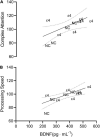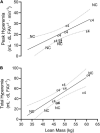An examination of the relationship among plasma brain derived neurotropic factor, peripheral vascular function, and body composition with cognition in midlife African Americans/Black individuals
- PMID: 36092801
- PMCID: PMC9453229
- DOI: 10.3389/fnagi.2022.980561
An examination of the relationship among plasma brain derived neurotropic factor, peripheral vascular function, and body composition with cognition in midlife African Americans/Black individuals
Abstract
African American/Black individuals have been excluded from several lines of prominent neuroscience research, despite exhibiting disproportionately higher risk factors associated with the onset and magnitude of neurodegeneration. Therefore, the objective of the current investigation was to examine potential relationships among brain derived neurotropic factor (BDNF), peripheral vascular function, and body composition with cognition in a sample of midlife, African American/Black individuals. Midlife adults (men: n = 3, 60 ± 4 years; women: n = 9, 58 ± 5 years) were invited to complete two baseline visits separated by 4 weeks. Peripheral vascular function was determined by venous occlusion plethysmography, a dual-energy X-ray absorptiometry was used to determine body composition, and plasma was collected to quantify BDNF levels. The CNS Vital Signs computer-based test was used to provide scores on numerous cognitive domains. The principal results included that complex attention (r = 0.629) and processing speed (r = 0.734) were significantly (p < 0.05) related to the plasma BDNF values. However, there was no significant (p > 0.05) relationship between any vascular measure and any cognitive domain or BDNF value. Secondary findings included the relationship between lean mass and peak hyperemia (r = 0.758) as well as total hyperemia (r = 0.855). The major conclusion derived from these results was that there is rationale for future clinical trials to use interventions targeting increasing BDNF to potentially improve cognition. Additionally, these results strongly suggest that clinicians aiming to improve cognitive health via improvements in the known risk factor of vascular function should consider interventions capable of promoting the size and function of skeletal muscle, especially in the African American/Black population.
Keywords: Alzheimer’s disease; body composition; brain derived neurotropic factor; cognition; exercise; health disparities.
Copyright © 2022 Traylor, Bauman, Saiyasit, Frizell, Hill, Nelson and Keller.
Conflict of interest statement
The authors declare that the research was conducted in the absence of any commercial or financial relationships that could be construed as a potential conflict of interest.
Figures



References
-
- Bailey T. G., Klein T., Meneses A. L., Stefanidis K. B., Ruediger S., Green D. J., et al. (2022). Cerebrovascular function and its association with systemic artery function and stiffness in older adults with and without mild cognitive impairment. Eur. J. Appl. Physiol. 122 1843–1856. 10.1007/s00421-022-04956-w - DOI - PMC - PubMed
Grants and funding
LinkOut - more resources
Full Text Sources

